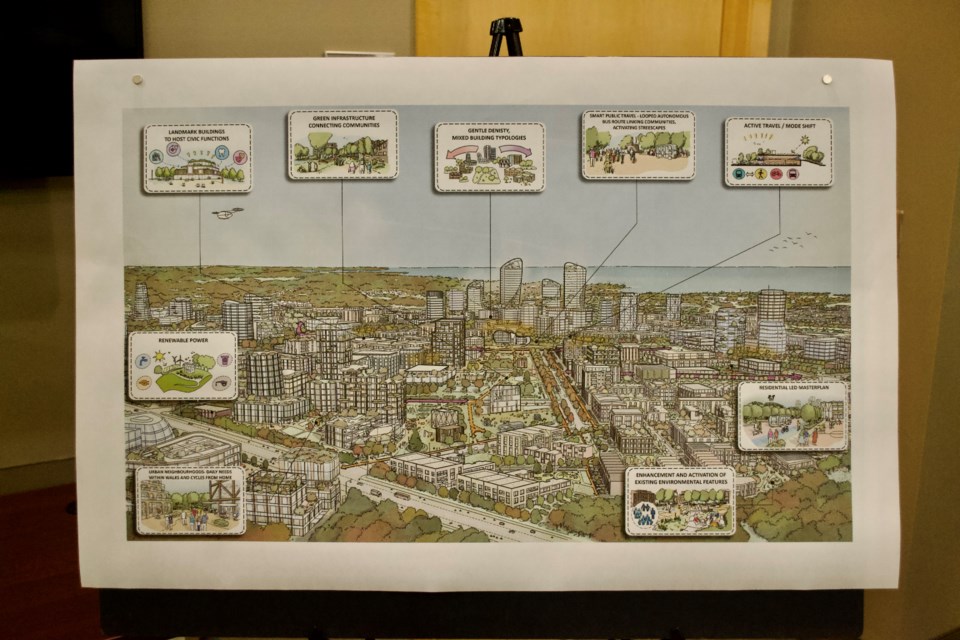More than 100 residents got a peek into the future of Innisfil last night.
An Orbit Potential and Innovation Plan community meeting took place at Innisfil Town Hall on Thursday where many residents got their first chance to see some of the proposals for the Orbit development, which is expected to bring unprecedented change to the municipality.
If the concepts presented last night come to fruition, the development could add more than 83,000 residents to Innisfil by 2091.
“We know this growth is coming,” said Innisfil Mayor Lynn Dollin. “We just have to look south to Vaughan. In 1980, Vaughan had 27,000 people — now they have 320,000. We’re 20 minutes up the road.”
While the growth proposed for Innisfil to 2051 isn’t anticipated to be that exponential, an additional 40,000 residents are expected to call the town home just three decades from now. The Orbit development is proposed to handle about half of them.
The Orbit is a transit-oriented community hub planned around a new GO station on Line 6 land owned by Cortel Group, near the 20th Sideroad in the Alcona area.
The Oct. 27 community meeting was deemed a “work in progress,” which Innisfil CAO Oliver Jerschow called an “important milestone.”
He was also happy to see so many people attend.
“It’s really important that we get input from our community,” Jerschow said. “So, seeing so many people come out, take an interest, ask great questions, it’s really valuable.”
Dollin echoed his comments.
“What makes me excited tonight is to see so many people here from the community and having that engagement with everybody,” she said. “This is the first opportunity to kind of dive into the details of the Secondary Plan and I think they are still soaking it all in.”
Thursday’s meeting was split into three sections, with two open question-and-answer sessions held around a formal presentation, where the general concepts as they stand today were shared.
Dollin, Jerschow, other members of town staff and council worked the room with the consultants as residents went deeper into what was being presented.
“I’m hearing a lot of different things,” Jerschow said. “People are coming with different interests, they’re asking about sustainability; they’re asking about schools and community services; they’re asking about even just basic stuff, like ‘Where’s all the parking?’ They’re asking all the right questions for this point in the process.”
The community has played an active role in getting the project to this stage. Prior to the meeting, the Orbit project team held a series of consultations in June where community stakeholders discussed what they wanted to see occur with the development, adding to the feedback already taken in, including nearly 500 survey responses received by early 2020.
The project team showcased a proposal that calls for four “15-minute districts” within the greater Orbit development, where people can get everything they need – from groceries to recreation to public transportation – within 15 minutes.
The Orbit proposal, Dollin said, allows the town to build the way it wants to and in a way that bucks conventional suburban thinking.
“One of the original reasons for the Orbit is because we know we’re going to have to absorb this population into our community,” she said. “How do we do it by giving us something different than we already have, which is single-family dwellings? But also, how do we do it to preserve some of our traditional neighbourhoods and our green spaces and our farms?”
The consultants used the response from the public received so far to design an area where nearly half of the nearly 600 hectares that will make up the Orbit will be reserved for parkland. They told the community members in attendance that the project essentially begins with the parks, designed through a synthesis of both radial and arterial design principles. Public and active transportation is then added to complement the parks system, with housing and employment eventually completing the community.
While the developers plan to start with parks and build up from there, the backbone of the development is the Barrie GO Line, which runs through the proposal. Even with the proposed GO train station being shifted away from Line 6, it remains the focal point of the project in many ways. The residential buildings with the greatest density – reaching perhaps 40 stories tall – will be closest to the station. Densities will decrease as the development radiates further away.
Currently, as Dollin pointed out, few, if any, residents can walk to the nearest GO station.
But that’s not the only problem the Orbit could solve.
“Right now, if you’re getting older and you have a three-bedroom home and stairs and a yard to cut the grass, you have to move out of town; there’s no place for you here,” the mayor said. “We want to be able to provide that, as well as obtainable housing for younger people who are just getting started and maybe have a job in the city and can have an affordable place to live — and a beautiful place to live — close to the lake here.”
While the town has undertaken large-scale projects previously, none have been as transformative as the Orbit promises to be. Nor will it be something that will be completed with pace, but Jerschow is convinced Innisfil has the right people in place to keep the project moving and the residents’ expectations satisfied.
“We just have to be honest with people,” he said. “It’s a long project and recognize that it will be built over time, it will be built in phases. We need to plan for the long term; that’s why we’re taking that long view. We’re not going to see it all tomorrow.”
The presentation was also live-streamed and can be viewed here.
A public information centre on the Secondary Plan is planned for December with adoption by council hoped to occur in early 2023.



